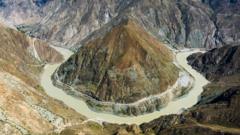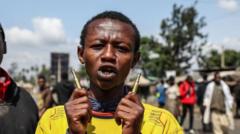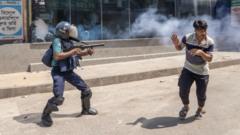Protests in Tibet against the construction of the Gangtuo dam have uncovered severe governmental backlash, including arrests and injuries to demonstrators. Despite the Chinese government's emphasis on development, the situation reflects ongoing tensions surrounding human rights and the preservation of Tibetan cultural heritage.
Tibetan Protests Erupt Over Controversial Dam Construction Amid Crackdown

Tibetan Protests Erupt Over Controversial Dam Construction Amid Crackdown
Unprecedented protests in Tibet against a proposed dam have led to violent crackdowns by Chinese authorities, raising serious concerns about human rights and environmental conservation.
In February of this year, Tibetan territory witnessed an extraordinary eruption of protests against a planned hydropower project on the Jinsha River. The Gangtuo dam, which is expected to flood culturally significant areas and displace thousands of residents, ignited fierce demonstrations, leading to brutal crackdowns by Chinese authorities. Reports indicate that hundreds of Tibetans were rounded up, numerous individuals endured physical assaults, and those who dared to speak out faced severe repercussions.
Historically, Tibet has been a hotbed for governmental oppression ever since China annexed the region in the 1950s, making these protests exceptionally rare. Witness accounts, corroborated by verified videos, revealed scenes of desperation, with monks and civilians pleading with authorities for the cessation of planned evictions. The Gangtuo dam's construction threatens to submerge notable cultural sites, including the ancient Wangdui Monastery, raising alarm among local populations.
The complexity surrounding the dam plans has been evident since their approval in 2012, with significant concerns about the project’s environmental and social impacts. A recent letter from United Nations officials highlighted the severe lack of consultation with local residents, suggesting that their fundamental rights to protest and express dissent were suppressed.
While Chinese officials insist that development will uplift local communities and had previously promised public consultations, many villagers reported that they received insufficient information about the impacts of the dam, or that their voices went unheard. Tensions escalated when residents faced imminent eviction notices, prompting peaceful protests that were met with overwhelming force from state officials.
Eyewitness accounts of state-sponsored violence emerged shortly after the protests, leading to widespread condemnation from human rights advocates. Numerous individuals were reportedly detained for long periods, with alarming reports of torture and beatings during interrogation sessions. The international community is left questioning these actions in light of China’s commitment to safeguarding human rights.
In parallel, the Chinese government emphasizes that large-scale dam constructions like Gangtuo are part of a broader strategy to transition to renewable energy sources and promote economic growth. However, advocates warn of the undeniable cultural and ecological costs associated with such projects.
With tensions simmering and communication restricted after the crackdown, many Tibetans remain fearful of further state reprisals. Human rights organizations have begun calling for a halt to the dam projects, advocating for the preservation of Tibetan land and culture. The situation serves as a stark reminder of the ongoing struggles faced by indigenous populations in the face of industrial progress and state control.
As the narrative unfolds, it becomes evident that the clash between development, environmental conservation, and human rights in Tibet is far from over, with the dam’s proposed construction becoming a focal point for broader socio-political unrest.
Historically, Tibet has been a hotbed for governmental oppression ever since China annexed the region in the 1950s, making these protests exceptionally rare. Witness accounts, corroborated by verified videos, revealed scenes of desperation, with monks and civilians pleading with authorities for the cessation of planned evictions. The Gangtuo dam's construction threatens to submerge notable cultural sites, including the ancient Wangdui Monastery, raising alarm among local populations.
The complexity surrounding the dam plans has been evident since their approval in 2012, with significant concerns about the project’s environmental and social impacts. A recent letter from United Nations officials highlighted the severe lack of consultation with local residents, suggesting that their fundamental rights to protest and express dissent were suppressed.
While Chinese officials insist that development will uplift local communities and had previously promised public consultations, many villagers reported that they received insufficient information about the impacts of the dam, or that their voices went unheard. Tensions escalated when residents faced imminent eviction notices, prompting peaceful protests that were met with overwhelming force from state officials.
Eyewitness accounts of state-sponsored violence emerged shortly after the protests, leading to widespread condemnation from human rights advocates. Numerous individuals were reportedly detained for long periods, with alarming reports of torture and beatings during interrogation sessions. The international community is left questioning these actions in light of China’s commitment to safeguarding human rights.
In parallel, the Chinese government emphasizes that large-scale dam constructions like Gangtuo are part of a broader strategy to transition to renewable energy sources and promote economic growth. However, advocates warn of the undeniable cultural and ecological costs associated with such projects.
With tensions simmering and communication restricted after the crackdown, many Tibetans remain fearful of further state reprisals. Human rights organizations have begun calling for a halt to the dam projects, advocating for the preservation of Tibetan land and culture. The situation serves as a stark reminder of the ongoing struggles faced by indigenous populations in the face of industrial progress and state control.
As the narrative unfolds, it becomes evident that the clash between development, environmental conservation, and human rights in Tibet is far from over, with the dam’s proposed construction becoming a focal point for broader socio-political unrest.




















